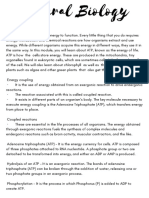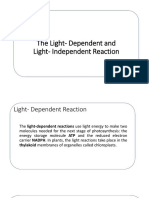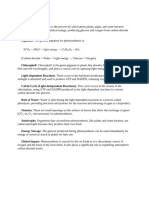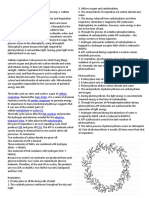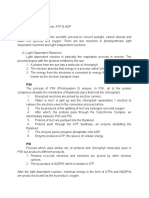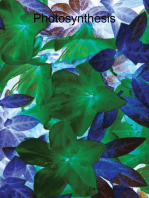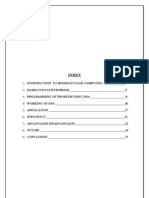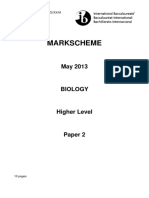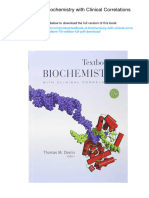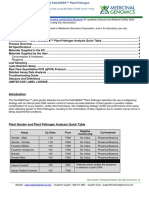0 ratings0% found this document useful (0 votes)
5 viewsScience Reviewer.
Science Reviewer.
Uploaded by
harlanecarlsPhotosynthesis is the process by which plants, algae, and some bacteria use sunlight, water and carbon dioxide to produce oxygen and energy in the form of glucose. It occurs in two phases - the light-dependent phase which uses energy from sunlight to produce ATP and NADPH, and the light-independent phase called the Calvin cycle which uses these products to fix carbon and produce glucose through a series of reduction and regeneration reactions. The Calvin cycle involves carbon fixation, reduction of the six-carbon compound, carbohydrate formation through conversion to G3P and glucose, and regeneration of RuBP to complete the cycle.
Copyright:
© All Rights Reserved
Available Formats
Download as DOCX, PDF, TXT or read online from Scribd
Science Reviewer.
Science Reviewer.
Uploaded by
harlanecarls0 ratings0% found this document useful (0 votes)
5 views3 pagesPhotosynthesis is the process by which plants, algae, and some bacteria use sunlight, water and carbon dioxide to produce oxygen and energy in the form of glucose. It occurs in two phases - the light-dependent phase which uses energy from sunlight to produce ATP and NADPH, and the light-independent phase called the Calvin cycle which uses these products to fix carbon and produce glucose through a series of reduction and regeneration reactions. The Calvin cycle involves carbon fixation, reduction of the six-carbon compound, carbohydrate formation through conversion to G3P and glucose, and regeneration of RuBP to complete the cycle.
Copyright
© © All Rights Reserved
Available Formats
DOCX, PDF, TXT or read online from Scribd
Share this document
Did you find this document useful?
Is this content inappropriate?
Photosynthesis is the process by which plants, algae, and some bacteria use sunlight, water and carbon dioxide to produce oxygen and energy in the form of glucose. It occurs in two phases - the light-dependent phase which uses energy from sunlight to produce ATP and NADPH, and the light-independent phase called the Calvin cycle which uses these products to fix carbon and produce glucose through a series of reduction and regeneration reactions. The Calvin cycle involves carbon fixation, reduction of the six-carbon compound, carbohydrate formation through conversion to G3P and glucose, and regeneration of RuBP to complete the cycle.
Copyright:
© All Rights Reserved
Available Formats
Download as DOCX, PDF, TXT or read online from Scribd
Download as docx, pdf, or txt
0 ratings0% found this document useful (0 votes)
5 views3 pagesScience Reviewer.
Science Reviewer.
Uploaded by
harlanecarlsPhotosynthesis is the process by which plants, algae, and some bacteria use sunlight, water and carbon dioxide to produce oxygen and energy in the form of glucose. It occurs in two phases - the light-dependent phase which uses energy from sunlight to produce ATP and NADPH, and the light-independent phase called the Calvin cycle which uses these products to fix carbon and produce glucose through a series of reduction and regeneration reactions. The Calvin cycle involves carbon fixation, reduction of the six-carbon compound, carbohydrate formation through conversion to G3P and glucose, and regeneration of RuBP to complete the cycle.
Copyright:
© All Rights Reserved
Available Formats
Download as DOCX, PDF, TXT or read online from Scribd
Download as docx, pdf, or txt
You are on page 1of 3
Module 1:
Photosynthesis is the food-making process which converts light energy from
the sun into chemical energy in food. The process requires molecules of water
and carbon dioxide in the presence of sunlight and chlorophyll to produce the
food (glucose) and release the by-product oxygen. Organisms which contain
chlorophyll like algae and plants can perform photosynthesis. The
chlorophylls of the chloroplast are the green pigment which absorbs the light
energy from the sun. Inside the chloroplasts are disc shaped structures called
thylakoids which contain chlorophylls. Thylakoids are stacked to form a
granum. Not all organisms which can perform photosynthesis possess
chloroplasts. If chlorophylls are present in any part of the organism, food
making can take place.
The leaves are the main area for photosynthesis. The leaf has mesophyll
layers in between the upper and lower epidermis. Each epidermis has stomata
which allows the carbon dioxide to enter and the oxygen to leave. Stomates
are guard cells which regulate the gas exchange in the leaves. When the guard
cells absorb water, it becomes turgid and opens. When it loses water, it
becomes flaccid and closes. Lower epidermis has more stomates than upper
epidermis. The mesophyll layers are the palisade and the spongy.
Photosynthesis occurs more on the palisade with closely packed parenchyma
cells. The spongy layer is loosely arranged to allow gas to move.
Photosynthesis is divided into two phases. The light dependent phase and the
light independent phase. The light dependent phase occurs in the thylakoids
of the chloroplast. It requires the presence of light energy and water. This part
produces ATP and NADPH needed for the next phase of photosynthesis
The absorption of light in the light dependent phase or light reaction involves
two photosystems: PI and PII. The photosystems contain light harvesting
pigments and proteins. The light harvesting pigments passes the energy to
the reaction center. PII contains the reaction center P680 and the PI contains
the reaction center P700.
When the light energy strikes the leaves, chlorophylls in photosystem II
capture the energy and passes it to the P680 reaction center. The energy
excites the electrons of the chlorophyll and moves to a series of electron
acceptors. The lost electron is replaced by the electron from the water due to
photolysis (the splitting of water into H ion, electron, and oxygen due to the
heat from the sun)
The same event occurs in photosystem II. The high energy electron ejected
out and moves to a series of electron acceptors. In the PII, the lost electrons
are replaced by electrons from water while in PI, the lost electrons are
replaced by the electrons from PII. The final electron acceptor in the process
is NADP- to produce NADPH. It is very important to remember that the
movement of energy in both photosystems is simultaneous since electrons in
both P680 and P700 are activated by the energy received from the sun.
As the high energy electron moves from one acceptor to another, it loses
energy. This released energy is used to produce ATP in the presence of the
enzyme
ATP synthase. The production of ATP can be of two ways. Cyclic
Photophosphorylation and Non-cyclic Photophosphorylation. In the non-cyclic
photophosphorylation, the electron moves from the PII. to PI, until the last
electron acceptor NADP-. In this process ATP and NADPH are produced. In
the cyclic photophosphorylation, the electrons follow a cyclic path in
producing ATP. It is important to remember that in light-dependent reaction,
the following
events occurred: 1. activation of the electron in the chlorophylls of P680 and
P700; 2. photolysis; and 3. Photophosphorylation: Non-cyclic and Cyclic. The
raw material is water, and the products are ATP and NADPH. Oxygen is a by-
product. The light-independent phase of photosynthesis occurs in the stroma
of the chloroplasts. It is also called Calvin Cycle or Dark reaction. This process
occurs once the products of the light-dependent reaction are available.
The Calvin cycle has four main steps: carbon fixation, reduction phase,
carbohydrate formation, and regeneration phase. Energy to fuel chemical
reactions in this sugar-generating process is provided by ATP and NADPH,
chemical compounds which contain the energy plants have captured from
sunlight.
Carbon fixation. Carbon in the molecule of carbon dioxide (CO2) is fixed from
an inorganic to an organic molecule. An enzyme Rubisco combines carbon
dioxide and RuBp to produce an organic molecule with six carbon organic
compound.
Reduction Phase. the six-carbon compound is reduced into phosphoglyceric
acid (3-PGA) and further converted into phosphoglyceraldehyde (G3P) using
electrons supplied by ATP and NADPH, then ATP and NADPH are converted to
ADP and NADP+, respectively.
Carbohydrate Formation. The G3P will be converted into glucose. Two G3Ps
are needed to make one glucose. For every turn of the cycle, only one carbon
dioxide molecule is needed to produce one G3P, thus six carbon dioxide
molecules are needed to make two G3P for one glucose molecule and the rest
for regeneration.
Regeneration Phase. The G3Ps produced in the cycle are used to make
glucose and regenerate RuBP. Three more molecules of ATP are used in these
regeneration reactions.
It is important to remember that the Calvin Cycle uses six carbon dioxides to
produce one glucose. In the process, ATPs and NADPH from the light reaction
are used to fix the carbon dioxide and produce glucose and regenerate the
RuBP. It is called light independent phase because it is not directly powered
by light.
You might also like
- Human Anatomy 9th Edition Martini Test BankDocument31 pagesHuman Anatomy 9th Edition Martini Test BankKevinHarrisoncatjn100% (11)
- Chapter 3 - Diffusion & OsmosisDocument26 pagesChapter 3 - Diffusion & Osmosisapi-3728508100% (6)
- Experiment 2:dna TechnologyDocument6 pagesExperiment 2:dna TechnologycheckerskNo ratings yet
- Energy TransformationDocument4 pagesEnergy TransformationAsh Nico BanquilloNo ratings yet
- Stages of Photosynthesis: Light ReactionsDocument7 pagesStages of Photosynthesis: Light ReactionsgtaliteNo ratings yet
- Photosynthesis: Study Guide Photosynthesis Equation: 6CO2 + 6H2O - C6H12O6 + 6O2Document4 pagesPhotosynthesis: Study Guide Photosynthesis Equation: 6CO2 + 6H2O - C6H12O6 + 6O2vscolegit shoppeNo ratings yet
- Lab 4 - Introduction and Protocol - F2024Document14 pagesLab 4 - Introduction and Protocol - F2024emmanuella.akhigbeNo ratings yet
- Photosynthesis: Leaves and Leaf StructureDocument11 pagesPhotosynthesis: Leaves and Leaf StructureMatthew BetinolNo ratings yet
- BiologyDocument4 pagesBiologyKomana SangarNo ratings yet
- 15 PhotosynthesisDocument10 pages15 PhotosynthesisEarl Adam LambacoNo ratings yet
- Photosynthesis and GlycolysisDocument6 pagesPhotosynthesis and Glycolysisralphdenmarkcalamasa21No ratings yet
- Gen Bio Mod 9-11Document7 pagesGen Bio Mod 9-11Arabella BrionesNo ratings yet
- Ap Bio Guided Reading Chapter 10 (Photosynthesis)Document4 pagesAp Bio Guided Reading Chapter 10 (Photosynthesis)nikisepanj83% (6)
- Hotosynthesis: Big PictureDocument3 pagesHotosynthesis: Big Picturehomamunfat100% (1)
- Biology Unit 4 Part 1 Last Minute Revision ReallyacademicsDocument67 pagesBiology Unit 4 Part 1 Last Minute Revision ReallyacademicsWill AndyNo ratings yet
- Chloroplasts UpdatedDocument4 pagesChloroplasts Updateddrug123addict25No ratings yet
- Photosynthesis 123Document4 pagesPhotosynthesis 123Alyssa L.J. Dela Cruz (Aly)No ratings yet
- The Light Dependent and Light Independent Reaction LECTUREDocument20 pagesThe Light Dependent and Light Independent Reaction LECTUREMOSIGAN, Vince EmanNo ratings yet
- Topic 8 PhotosynthesisDocument8 pagesTopic 8 Photosynthesiskevingetare50No ratings yet
- 623171977-GenBio-1-2nd-Quarter-ReviewerDocument8 pages623171977-GenBio-1-2nd-Quarter-ReviewerAngelanne LegardaNo ratings yet
- PhotosynthesisDocument31 pagesPhotosynthesismmobrecarinNo ratings yet
- GenBio 1 - 2nd Quarter ReviewerDocument8 pagesGenBio 1 - 2nd Quarter Reviewerjoshua tejada100% (1)
- Photosynthesis 5.2.1Document5 pagesPhotosynthesis 5.2.1bexNo ratings yet
- Independent and Dependent ReactionsDocument4 pagesIndependent and Dependent Reactionsezraisagon422No ratings yet
- ScienceDocument9 pagesScienceWeam HassnNo ratings yet
- Photosynthesis Cell Biology FileDocument16 pagesPhotosynthesis Cell Biology FileRei KaplanNo ratings yet
- Photosynthesis Cell Biology FileDocument16 pagesPhotosynthesis Cell Biology FileRei KaplanNo ratings yet
- Chapter 2 PhotosynthesisDocument41 pagesChapter 2 PhotosynthesisTshering ChodenNo ratings yet
- SSGBIO1 - CM Week 7Document61 pagesSSGBIO1 - CM Week 7christine ManuelNo ratings yet
- Report Group 11Document5 pagesReport Group 11Boyd benson kayomboNo ratings yet
- STPM BIOLOGY PhotosynthesisDocument13 pagesSTPM BIOLOGY Photosynthesiswkwhui100% (6)
- Photosynthesis in Higher PlantsDocument8 pagesPhotosynthesis in Higher PlantsAditya VenkatNo ratings yet
- Photosynthesis and RespirationDocument4 pagesPhotosynthesis and RespirationChristian BaleNo ratings yet
- Unveiling The Light Reaction Event in PhotosynthesisDocument18 pagesUnveiling The Light Reaction Event in Photosynthesiszbplayer8No ratings yet
- PhotosynthesisDocument14 pagesPhotosynthesisValerie Duran-ArzagaNo ratings yet
- Utilizing Energy For LifeDocument41 pagesUtilizing Energy For LifeJOHN PAUL MACALLINGNo ratings yet
- Photosynthesis in Higher PlantsDocument13 pagesPhotosynthesis in Higher PlantsAjay JamwalNo ratings yet
- PhotosynthesisDocument52 pagesPhotosynthesisAdelaide CNo ratings yet
- Photosynthesis and Cellular RespirationDocument8 pagesPhotosynthesis and Cellular RespirationFatima DariaNo ratings yet
- Lecture: 2.3 PHOTOSYNTHESIS: Photosynthesis Converts Light Energy To Chemical Energy of FoodDocument2 pagesLecture: 2.3 PHOTOSYNTHESIS: Photosynthesis Converts Light Energy To Chemical Energy of FoodLorena DizonNo ratings yet
- PHOTOSYNTHESISDocument10 pagesPHOTOSYNTHESISNur SafirahNo ratings yet
- PhotosynthesisDocument3 pagesPhotosynthesisCristina MaquintoNo ratings yet
- 13 PhotosynthesisDocument38 pages13 PhotosynthesisKrystelle Joann DarrocaNo ratings yet
- Form Carbohydrate That Is Usable by The BodyDocument5 pagesForm Carbohydrate That Is Usable by The BodyEmman RevillaNo ratings yet
- GROUP 3 and 4 Light ReactionsDocument20 pagesGROUP 3 and 4 Light ReactionsalvarezmarymellNo ratings yet
- Photosynthesis ReadingDocument11 pagesPhotosynthesis ReadingLogan ParkisonNo ratings yet
- Photosynthesis Interactive Part 1Document2 pagesPhotosynthesis Interactive Part 1api-522847737No ratings yet
- AGR122 CHAPTER 4.3-PHOTOSYNTHESIS BaruDocument38 pagesAGR122 CHAPTER 4.3-PHOTOSYNTHESIS BaruAisyah NabilaNo ratings yet
- Biotech Pres 29032016Document36 pagesBiotech Pres 29032016Marza ZareenNo ratings yet
- Series of EventsDocument10 pagesSeries of EventsMarvin JeaNo ratings yet
- Group 4 PhotosynthesisDocument11 pagesGroup 4 PhotosynthesisJv Dela CruzNo ratings yet
- 2nd Quarter - Gen. Bio.1Document38 pages2nd Quarter - Gen. Bio.1Reylyn SantiagoNo ratings yet
- AP Bio Unit 2 Study GuideDocument2 pagesAP Bio Unit 2 Study GuideRana MehaiNo ratings yet
- Photosynthesis: 6CO2+6H2O+light Energy C6H12O6 + 6O2Document3 pagesPhotosynthesis: 6CO2+6H2O+light Energy C6H12O6 + 6O2louNo ratings yet
- EngBio PTH Lecture1 3c TextDocument3 pagesEngBio PTH Lecture1 3c Textnguyenthihoaingoct67No ratings yet
- Cellular Respiration Hans Krebs Aerobic OrganismsDocument1 pageCellular Respiration Hans Krebs Aerobic OrganismsMia SoteloNo ratings yet
- PhotosynthesisDocument21 pagesPhotosynthesissujoysarkargurgaonNo ratings yet
- General Biology - Photosynthesis, ATP and ADPDocument4 pagesGeneral Biology - Photosynthesis, ATP and ADPAnnalee MacarayaNo ratings yet
- PHOTOSYNTHESISDocument7 pagesPHOTOSYNTHESISKate Andrea GuiribaNo ratings yet
- Edexcel Igcse Biology PhotosynthesisDocument8 pagesEdexcel Igcse Biology PhotosynthesisKamrul Alam MasumNo ratings yet
- hEALTH9 Q2 Module2Document16 pageshEALTH9 Q2 Module2harlanecarlsNo ratings yet
- SCI8 - Q3 - M4 - The Periodic Table of ElementsDocument21 pagesSCI8 - Q3 - M4 - The Periodic Table of ElementsharlanecarlsNo ratings yet
- Electrical Service Entrance 1Document19 pagesElectrical Service Entrance 1harlanecarlsNo ratings yet
- Mapeh ReviewerDocument6 pagesMapeh ReviewerharlanecarlsNo ratings yet
- Quarter 3 Lighting Fixture and LampsDocument31 pagesQuarter 3 Lighting Fixture and LampsharlanecarlsNo ratings yet
- (Methods in Molecular Biology 1296) Mathieu Rederstorff (Eds.) - Small Non-Coding RNAs - Methods and Protocols-Humana Press (2015) PDFDocument239 pages(Methods in Molecular Biology 1296) Mathieu Rederstorff (Eds.) - Small Non-Coding RNAs - Methods and Protocols-Humana Press (2015) PDFMe100% (1)
- Patofisiologi BPHDocument3 pagesPatofisiologi BPHAhmad Khoirul RizalNo ratings yet
- 03 PharmacometabolomicsDocument11 pages03 PharmacometabolomicsVanessa CarreraNo ratings yet
- Lab Practical 2Document2 pagesLab Practical 2api-246382283No ratings yet
- Lysosomal Storage DiseaseDocument37 pagesLysosomal Storage Diseasehoria96No ratings yet
- Lesson 3 - Prokaryotic Vs Eukaryotic CellsDocument28 pagesLesson 3 - Prokaryotic Vs Eukaryotic Cellsloki75% (4)
- 1) Introduction To Biomolecular Computing 2) HamiltonDocument26 pages1) Introduction To Biomolecular Computing 2) Hamiltonsam2287100% (2)
- INSULINDocument54 pagesINSULINBalai Pom PaluNo ratings yet
- M13CDocument10 pagesM13CMiriam LópezNo ratings yet
- Spectrophotometric Determination of Protein' ReportDocument4 pagesSpectrophotometric Determination of Protein' ReportAhmad Nabaz Khalil HamasalihNo ratings yet
- Mitosis PPT EdittedDocument21 pagesMitosis PPT EdittedabdNo ratings yet
- Textbook of Biochemistry With Clinical Correlations. ISBN 0470281731, 978-0470281734Document23 pagesTextbook of Biochemistry With Clinical Correlations. ISBN 0470281731, 978-0470281734karaleegermanofie100% (12)
- Arguslab NavodilaDocument6 pagesArguslab NavodilaChandrakanthNo ratings yet
- Lecture 8 PDFDocument10 pagesLecture 8 PDFaaa rrNo ratings yet
- FemINDICAtor - Plant Pathogen - QPCR - Bio-RadDocument16 pagesFemINDICAtor - Plant Pathogen - QPCR - Bio-RadAndrea MarceloNo ratings yet
- PPP QuestionsDocument3 pagesPPP QuestionsHarun MohamedNo ratings yet
- Enzymes PPT NotesDocument41 pagesEnzymes PPT NotesANWESHA BALNo ratings yet
- Insider's Guide 37Document18 pagesInsider's Guide 37whiteyasmin100% (2)
- Advanced PCR - Methods and ApplicationsDocument21 pagesAdvanced PCR - Methods and ApplicationsNT RavindranNo ratings yet
- Analytica Chimica Acta: Ahmed Abdulrahman, Ashraf GhanemDocument17 pagesAnalytica Chimica Acta: Ahmed Abdulrahman, Ashraf GhanemRosyida AdiniaNo ratings yet
- Vector VoyageDocument45 pagesVector VoyageAshanna BeyNo ratings yet
- Regents Cell Membrane and DiffusionDocument5 pagesRegents Cell Membrane and Diffusionapi-303120399No ratings yet
- Chemical Properties of Amino Acids: Advanced ArticleDocument11 pagesChemical Properties of Amino Acids: Advanced ArticleazzaassNo ratings yet
- 2.2 Drug Absorption From The GITDocument15 pages2.2 Drug Absorption From The GITCari MosehuusNo ratings yet
- Blood GlucoseDocument8 pagesBlood Glucoseعبدالرحمن عابدNo ratings yet
- Biochemistry of Fermentation ProcessesDocument59 pagesBiochemistry of Fermentation ProcesseslazytinkuNo ratings yet
- DNA Replication in Prokaryotes ProjectDocument1 pageDNA Replication in Prokaryotes ProjectCliff LigulfNo ratings yet











